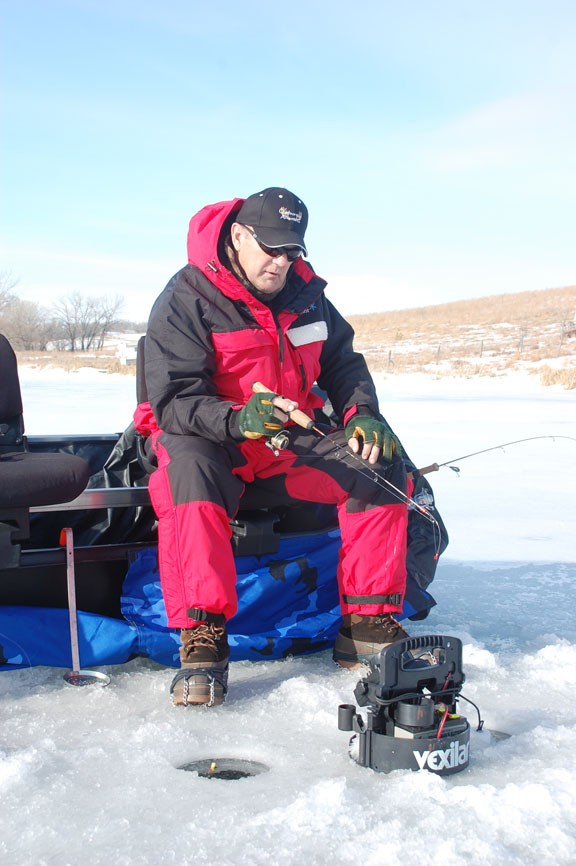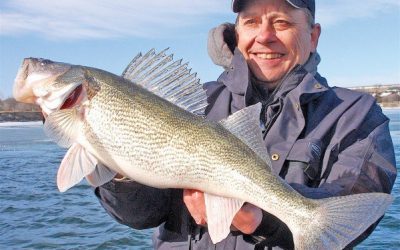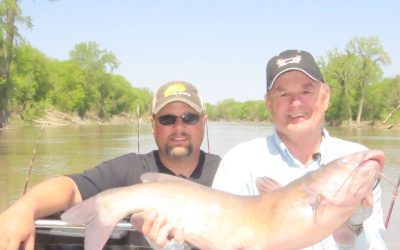Yes, I have been accused of being a bit crazy, which I am, “Crazy” about ice fishing.
I have iced fish ever since I was a youngster growing up in the Northeastern South Dakota near Watertown.
Back then, we would load our gear on our Flexible Flyer snow sled and follow the Sioux River out to Lake Pelican. We thought our gear was the pretty uptown! It consisted of a spud bar, broom handle rods, heavy line, a few bobbers, small hooks and a few minnows.
Our depth finder or locator was an old spark plug we tied to a piece of line.
To get a hole cut in the ice, we would us a spud bar we borrowed from our neighbor. For those of you who are not sure what a spud bar is, it is a long heavy steel rod with one end ground down to a chisel like point.
We’d use the bar to chip away at the ice to make our hole. The hole started out large at the top, as we knew we were going to be landing some monsters, so our hole had to be big. As we chipped away, with the bar getting heavier as we tired our hole would narrow.
One, possibly two holes were all my brother and I could chop because by that time we had them cut, we were exhausted.
The finish product looked like a funnel, with a wide opening at the top, with the hole at the bottom, just big enough to pull through a small perch or pike. I don’t know what we’d done if we’d caught a big fish.
Our rods were made from Mom’s broken broom handles with a couple of nails pounded into them where we wrap our line around.
Fishing line back then was either a heavy black Dacron or heavier primitive monofilament. The heavy Dacron would freeze stiff once it got wet and the mono would kink where it wrapped around the nails and wouldn’t straighten out no matter what you did.
The bobbers we used were big to say the least, way to large for the fish we were after as they would have died of exhaustion from trying to pull the bobber down and too large to be pilled very far down because of our funnel shaped holes.
Hooks were also too large, as we really didn’t have a choice of hook size. They were what we could borrow from my grandfather and neighbor. As far as we knew, we thought, one size hook fits all.
Since we were told or read that the fish always moved deep in the winter, we used our super duper depth locate, an old spark plug tied to some line, giving us some idea as to the depth we were fishing.
Then we would attach a bobber so the minnow suspended just off the bottom and set there all day waiting for a bite.
We may not have caught much and it is surprising that my brother A.J. and I kept ice fishing after such a dismal start.
Today, things are a lot different. Ice fishermen are much more comfortable, with our equipment being far more advanced!
The special clothing we wear, the special ice fishing bibs coveralls and parkas, polyester base layers, those that pull moisture away from our skin, our sweatshirts, hand warmers light weight heated boots and ice walkers make it much more comfortable, allowing us to spend more time on the ice during cold temperatures.
Our Team now fish out of our Frabill portable icehouse or portable sleds. You will not find us sitting in one spot very long unless the fish are really hammering our bait.
We drill dozens of holes in each area we intend to fish with our Jiffy propane augers. Because they run on the small propane canisters, we don’t worry about having our ice fishing gear and us smelling of gas.
Once we have the holes drilled, we rig up our graphite rods and ultra light reels spooled with line made especially for ice fishing like Berkley Fireline Micro-ice or Cold Weather line.
Ice fishermen still use plain hook, available in every size imaginable and there are hundreds of different micro ice jigs in numerous colors, including jigs specifically for walleyes, panfish and pike.
These jigs come in all shapes, sizes and weights, some, made from the heavier Tungsten with others so small that they are hard to see.
We use micro bobbers or foam floats we can cut, trimming them down so they will float just below the surface of the water. Because they are small, they offer very little resistance, allowing the fish to move off with your bait and not feel and extra weight.
We still use a type of bottom locator, one that clips on the lure, but what has really changed ice fishing is the knowledge we have gained by using good fish locators (Sonar) like the Vexilar units.
No longer do we simply set our bait just off the bottom and call it good!
We now know fish like the perch, crappie and walleye move both vertically and horizontally. They locate where their food source is and where they can find comfortable temperatures
With a good locator, you can see a walleye lying on the bottom and if a fish moves in under your hole, a good locator will show you the depth the fish is located. With a good locator, you’re able to see your jig and let you know if there still is bait on your jig.
Many years ago, on a trip to Lake Winnibigosh in Minnesota, we were fishing out of permanent ice houses because of the minus 22 degrees outside temperatures.
We noticed that our locators would light up or show a blip at 10 feet in 25 foot of water. One of our Team members brought his bait up to 10 foot, worked the bait at the same depth as the blip and in less than a minute, he hooked a good walleye, one located 15 feet off the bottom.
Perch and crappies are famous for this vertical movement. You just never know at what depth they might be cruising.
On another trip to Northeastern South Dakota to do some filming and ice fishing, on one of the many onetime sloughs that had become lakes near Watertown, South Dakota. We joined Team Outdoorsmen Adventures member, Watertown KWAT outdoor radio show host Don Fjerstad, Jr. Burns from Watertown and former Watertown resident Chuck Krause, where we found the perch scattered from the bottom to just a few feet below the ice.
Without a good locator, like our Vexilar, we would have wasted a lot of time waiting for the fish roaming in the deeper water to find our baits.
Thank God, for these changes, the days of spud bars and broom handle rods as if these changes hadn’t happened, I’m afraid my ice fishing days would have ended years ago
You do not need all of the things I mentioned to go ice fishing, but it sure makes the trip as lot more comfortable and a lot of fun!






0 Comments